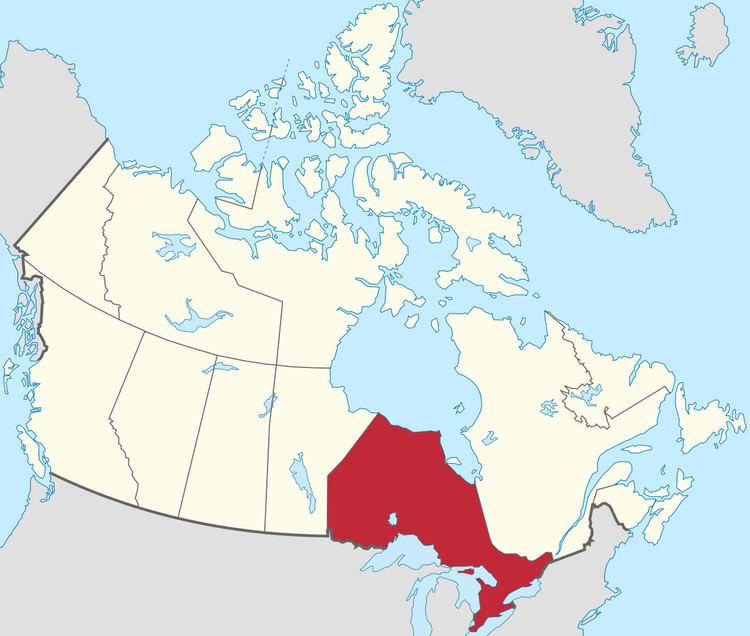 | ||
Ontario is the most populous province in Canada with 12,851,821 residents as of 2011 and is third-largest in land area at 908,608 km2 (350,816 sq mi). Ontario's 444 municipalities cover only 7001170000000000000♠17% of the province's land mass yet are home to 7001990000000000000♠99% of its population. These municipalities provide local or regional municipal government services within either a single-tier or shared two-tier municipal structure.
Contents
- Upper tier municipalities
- Local municipalities
- Single tier municipalities
- Lower tier municipalities
- References
A municipality in Ontario is "a geographic area whose inhabitants are incorporated" according to the Municipal Act, 2001. Ontario's three municipality types include upper and lower-tier municipalities within the two-tier structure and single-tier municipalities (unitary authorities) that are exempt from the two-tier structure. Single and lower-tier municipalities are grouped together as local municipalities. Of Ontario's 444 municipalities, 30 of them are upper-tier municipalities and 414 are local municipalities — 241 lower-tier municipalities and 173 single-tier municipalities.
The Municipal Act, 2001 is the legislation that enables incorporation and stipulates governance of Ontario's municipalities, excluding the City of Toronto, which is subject to the City of Toronto Act, 2006. The Municipal Act, 2001 provides lower and single-tier municipalities with the authority to incorporate as cities, towns, villages, townships, or generically as municipalities. There are no minimum population thresholds or other requirements for these municipal sub-types. A municipality can change its status to any of these so long as its resulting name is not being used by another municipality. For upper-tier municipalities, the act provides them with the authority to incorporate as counties, regions and district municipalities.
Ontario's largest municipality by population is the City of Toronto with 2,731,571 residents, while the largest by land area is the City of Greater Sudbury at 3,227.38 km2 (1,246.10 sq mi). The City of Ottawa, Canada's capital city, is the province's second-most populous municipality with 934,243 residents. Ontario's smallest municipality by population is the Township of Cockburn Island with 0 residents, while the smallest by land area is the Village of Westport at 1.71 km2 (0.66 sq mi). The first community to incorporate as a municipality in Ontario was Brockville in 1832.
Upper-tier municipalities
Ontario's Municipal Act, 2001 defines upper-municipality as "a municipality of which two or more lower-tier municipalities form part for municipal purposes." Ontario has 30 upper-tier municipalities that comprise multiple lower-tier municipalities, which have a total population of 6,261,245, a total land area of 87,913.78 km2 (33,943.70 sq mi). These upper-tier municipalities include 19 counties, 3 united counties and 8 regional municipalities or regions, all of which represent 30 of Ontario's 49 census divisions. Regional governments are responsible for arterial roads, health services, policing, region-wide land use planning and development, sewer and water systems, social services, transit, and waste disposal, whereas county governments have the lesser responsibilities of arterial roads, county land use planning, health services, and social services.
Local municipalities
Ontario's Municipal Act, 2001 defines local municipality as "a single-tier municipality or a lower-tier municipality". Combined, Ontario has 414 local municipalities comprising 173 single-tier municipalities and 241 lower-tier municipalities. The 414 local municipalities have a total population of 13,357,197, a total land area of 155,653 km2 (60,098 sq mi) and an average population of 32,264. These totals represent 7001993000000000000♠99.3% of Ontario's population and 7001171000000000000♠17.1% of its land area.
Single-tier municipalities
Ontario's Municipal Act, 2001 defines single-municipality as "a municipality, other than an upper-tier municipality, that does not form part of an upper-tier municipality for municipal purposes". In southern Ontario, single-tier municipalities are either politically separate from but geographically within neighbouring counties or were formed through the amalgamation of upper-tier and lower-tier municipalities. All municipalities in northern Ontario are single-tier municipalities as upper-tier municipalities are not present. Single-tier municipalities provide for all local government services. Ontario has 173 single-tier municipalities comprising 32 cities, 23 municipalities, 28 towns, 85 townships, and 5 villages.
Lower-tier municipalities
Ontario's Municipal Act, 2001 defines lower-tier municipality as "a municipality that forms part of an upper-tier municipality for municipal purposes". Ontario has 241 lower-tier municipalities comprising 19 cities, 39 municipalities, 62 towns, 115 townships and 6 villages. Within regions, they are responsible for providing certain local services that are not provided by the regional municipality. Within counties, they are responsible for providing a wider range of local services since counties as upper-tier municipalities provide less local services than regions.
